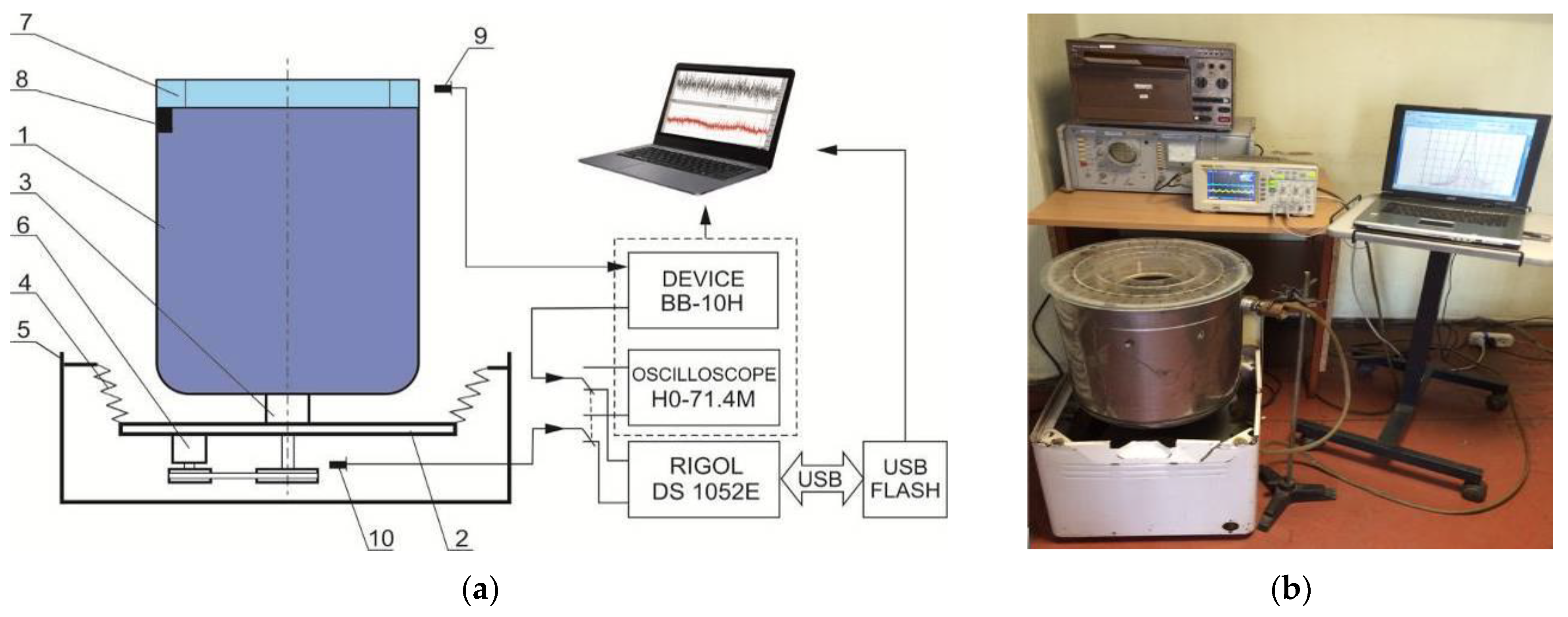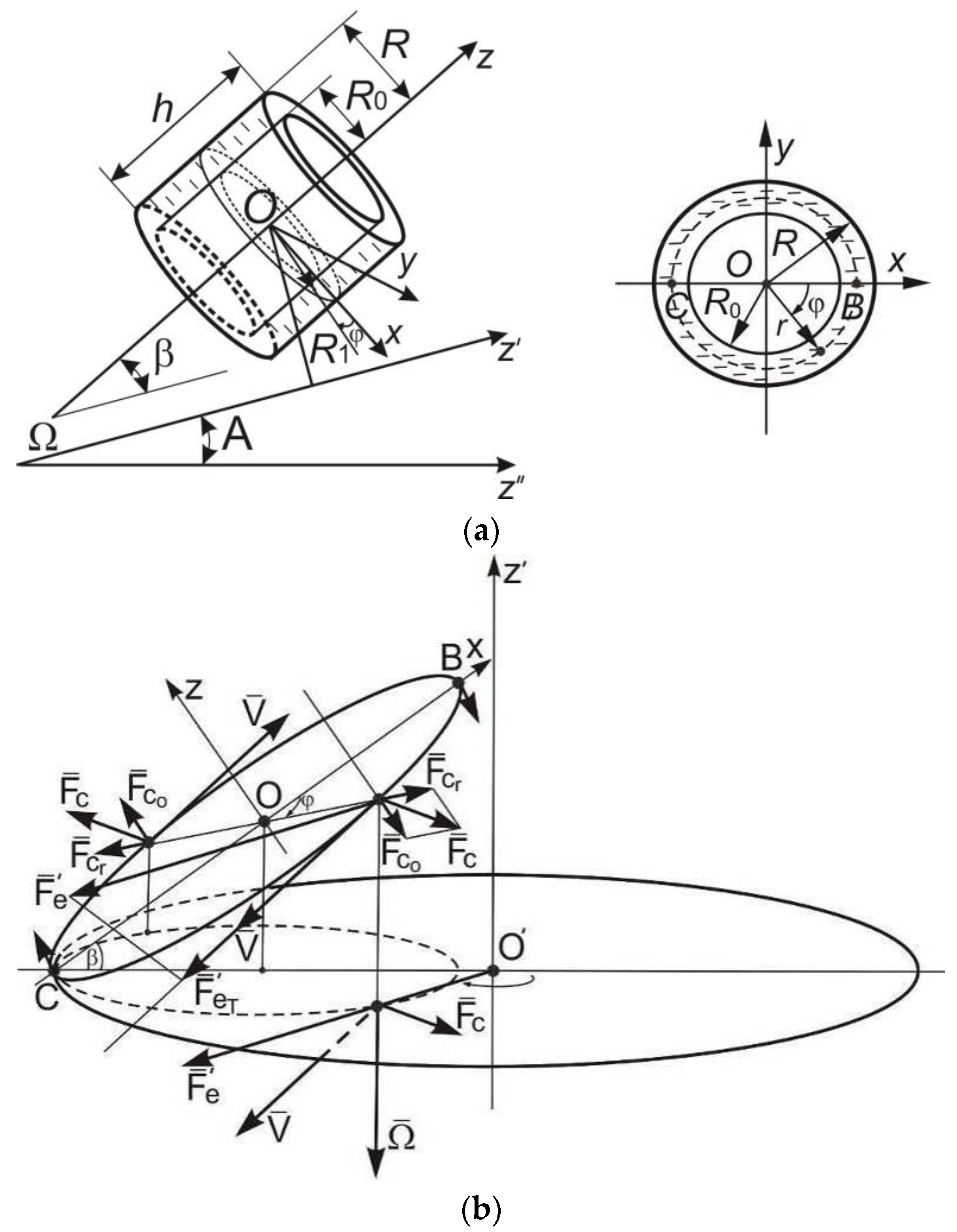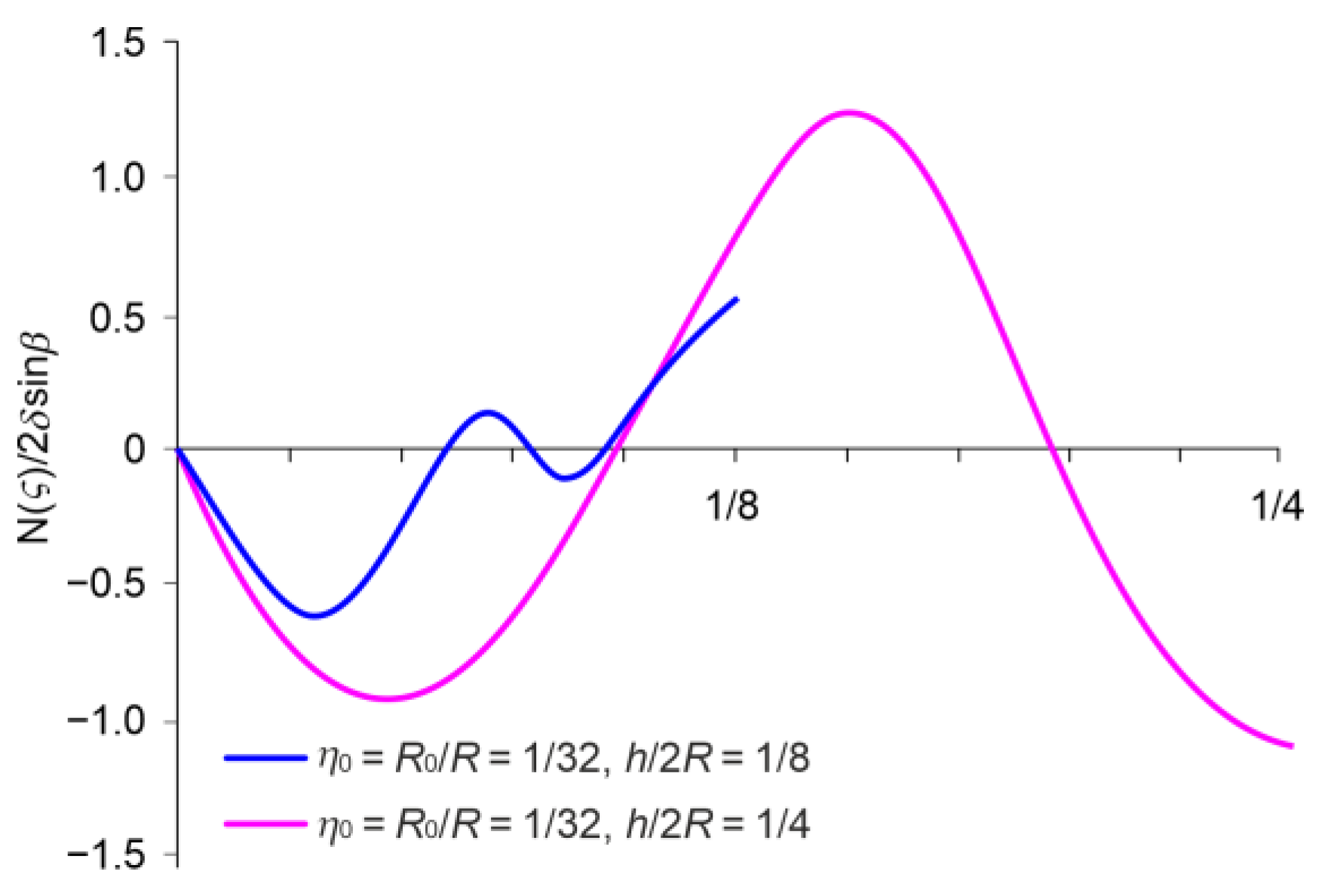The Inertial Disturbances of Fluid Movement in the Chamber of a Liquid Autobalancer
Abstract
:1. Introduction
- -
- Study the peculiar wave processes propagating in an incompressible liquid that rotates uniformly in a closed cylindrical chamber;
- -
- Detection of effects and phenomena associated with the action of Coriolis forces of inertia;
- -
- Substantiation of the impact of these phenomena on the operation of the liquid autobalancer and its design parameters;
- -
- Performing experimental verification of the results of theoretical studies on a specially designed experimental stand for studying the operation of a rotor system with a vertical axis of rotation.
2. Materials and Methods
2.1. Experimental Equipment
- (1)
- An experimental sample of the self-balancing device (cylindrical ring h = 50 mm high with an outer radius R = 200 mm, and two concentric partitions of radii R = 150 and R = 100 mm, forming three concentric chambers for placing the corrective (working) fluid in them). Three chambers are hermetically isolated. This makes it possible to investigate the dependence of the efficiency of the autobalancing process on the geometric dimensions of the camera;
- (2)
- Working fluid–fresh water (density 1.00 × 103 kg/M3, kinematic viscosity 1.01 × 10−6 m2/s at a temperature of 20 °C);
- (3)
- The experimental unit was developed on the basis of a drum-type washing–squeezing machine. The rotor is a drum that is rigidly fixed on the axis of rotation. On the upper edge of the drum, with the help of fasteners, a sample of the autobalancer is rigidly fixed, which ensures the coaxiality and sufficient rigidity of the rotor. The rotor axis is connected to the rigid platform through rolling bearings. The platform is connected to the body of the installation by four elastic damping suspensions. For the experimental setup, the following empirical logarithmic attenuation decrement = 0.854 was determined, and the damping coefficient n = 7.06.
- -
- Rotary movement of the rotor system, with different rotor rotation speeds in the range of 30–1080 rpm;
- -
- Different angular accelerations during acceleration (coasting) of the rotor;
- -
- The time of constant rotation in the pre-resonance, resonance, and post-resonance zones of the rotor rotation for detailed studies of the operation of the liquid autobalancer.
- -
- A step-by-step increase in the mass of the simulated imbalance (from 50 g to 250 g), which was placed on the inner wall of the drum near the free edge (the imbalance of the rotor D was from 1000 g∙cm to 5000 g∙cm);
- -
- A step-by-step increase in the liquid volume (from 50 mL to 450 mL) in chambers of different radii (R = 200 mm; 150 mm; 100 mm).
2.2. Mathematical Model of the Dynamics of the Liquid Rotating in the Cylindrical Chamber
- -
- To find the initial approximation to the solution of the problem:
- -
- To find the first approximation to the solution of the problem:
3. Results and Discussion
- (1)
- There is a sufficient volume of working fluid to balance the system, which creates an imbalance approximately equal to the imbalance of the rotor. Partially, for a chamber with a radius of 200 mm (h/2R = 1/8), it is 100 mL, for a chamber with a radius of 150 mm—150–200 mL, and for a chamber with a radius of 100 mm (h/2R = 1/4)—150–200 mL, with an imbalance mass of 150 g. The greatest balancing effect is achieved when the amount of liquid imbalance is close to the amount of simulated imbalance;
- (2)
- The range of rotor oscillations increases when the condition of fluid sufficiency is not met and the degree of chamber filling increases;
- (3)
- The effectiveness of liquid balancing is obvious (values of the range of oscillations of the upper edge of the drum, corresponding to V = 0 mL, significantly decrease when adding liquid);
- (4)
- The geometric parameters of the cavity have a significant influence on the efficiency of liquid self-balancing.
4. Conclusions
- -
- The presence of a sufficient volume of working fluid for effective balancing, and the greatest balancing effect is achieved when the amount of fluid imbalance is close to the amount of simulated imbalance;
- -
- An increase in the degree of filling the chamber with liquid leads to an increase in the range of oscillations of the rotor system;
- -
- An increase to the council ABD camera mouth provides a significant increase in balancing efficiency.
Author Contributions
Funding
Data Availability Statement
Acknowledgments
Conflicts of Interest
Nomenclature
| R | radius chamber ABD |
| H | height chamber ABD |
| ρ | liquid of density |
| R | R0 thickness of an annular layer of liquid |
| η0 | coefficient characterizing filling of the chamber with liquid |
| z | axis of the chamber |
| axis around which the camera rotates | |
| Β | angle of deviation of axis z from axis |
| R1 | radius of chamber rotation around axis |
| η = r/R, φ, ζ = z/R | dimensionless cylindrical coordinates |
| chamber ABD angular velocity | |
| fluid velocity relative to the chamber ABD | |
| P | pressure |
| ε, δ | parameters |
| transfer acceleration | |
| Coriolis acceleration | |
| velocity scale |
References
- Blanco-Ortega, A.; Silva-Navarro, G.; Coln-Ocampo, J.; Oliver-Salazar, M.; Vela-Valds, G. Automatic Balancing of Rotor-Bearing Systems; IntechOpen Limited: London, UK, 2012. [Google Scholar] [CrossRef]
- Li, L.; Cao, S.; Li, J.; Nie, R.; Hou, L. Review of Rotor Balancing Methods. Machines 2021, 9, 89. [Google Scholar] [CrossRef]
- Prysyazhnyuk, P.; Molenda, M.; Romanyshyn, T.; Ropyak, L.; Romanyshyn, L.; Vytvytskyi, V. Development of a hard banding material for drill pipes based on high-manganese steel reinforced with complex carbides. Acta Montan. Slovaca 2022, 27, 685–696. [Google Scholar] [CrossRef]
- Ropyak, L.; Shihab, T.; Velychkovych, A.; Bilinskyi, V.; Malinin, V.; Romaniv, M. Optimization of Plasma Electrolytic Oxidation Technological Parameters of Deformed Aluminum Alloy D16T in Flowing Electrolyte. Ceramics 2023, 6, 146–167. [Google Scholar] [CrossRef]
- Ishida, Y.; Yamamoto, T. Linear and Nonlinear Rotordynamics: A Modern Treatment with Applications, 2nd ed.; Wiley-VCH Verlag & Co.KGaA: Weinheim, Germany, 2012; p. 447. [Google Scholar] [CrossRef]
- Osinski, Z. Damping of Vibrations, 1st ed.; CRC Press: Boca Raton, FL, USA, 2018; Available online: https://www.perlego.com/book/1491406/damping-of-vibrations-pdf (accessed on 14 October 2023).
- Chen, H.-W.; Yuan, X.-T.; Zhen, S.; Mou, Q.-Q.; Xiong, M.; Wang, W.-H. Design and Analysis of an Active Balancing Mechanism for a Vertical Axis Washing Machine. Int. J. Precis. Eng. Manuf. 2022, 23, 763–778. [Google Scholar] [CrossRef]
- Pan, X.; He, X.; Wei, K.; Wu, H.; Gao, J.; Jiang, Z. Performance Analysis and Experimental Research of Electromagnetic-Ring Active Balancing Actuator for Hollow Rotors of Machine Tool Spindles. Appl. Sci. 2019, 9, 692. [Google Scholar] [CrossRef]
- Xu, X.; Fan, P.P. Rigid Rotor Dynamic Balancing by Two-plane Correction with the Influence Coefficient Method. In Applied Mechanics and Materials; Trans Tech Publications Ltd.: Wallerau, Switzerland, 2013; Volume 365, pp. 211–215. [Google Scholar] [CrossRef]
- Fan, H.W.; Jing, M.Q.; Wang, R.C.; Liu, H.; Zhi, J.J. New electromagnetic ring balancer for active imbalance compensation of rotating machinery. J. Sound Vibr. 2014, 333, 3837–3858. [Google Scholar] [CrossRef]
- Pan, X.; Xie, Z.; Lu, J.; Wu, H.Q.; Gao, J.J.; Jiang, Z.N. Novel Liquid Transfer Active Balancing System for Hollow Rotors of High-Speed Rotating Machinery. Appl. Sci. 2019, 9, 833. [Google Scholar] [CrossRef]
- Strautmanis, G.; Filimonikhin, G.; Mezitis, M.; Gorbenko, A.; Strautmane, V.; Sansyzbajeva, Z. Modelling of transient and steady-state modes of a vertical rotor with an automatic balancing device. J. Vibroeng. 2021, 23, 759–769. [Google Scholar] [CrossRef]
- Gorbenko, A.N.; Klimenko, N.P.; Strautmanis, G. Influence of Rotor Unbalance Increasing on its Autobalancing Stability. Procedia Eng. 2017, 206, 266–271. [Google Scholar] [CrossRef]
- Chung, J.; Ro, D.S. Dynamic analysis of an automatic dynamic balancer for rotating mechanisms. J. Sound Vibr. 1999, 228, 1035–1056. [Google Scholar] [CrossRef]
- Pan, X.; Ge, D.; Li, W.; Huo, J. Research on Pneumatic–liquid On-Line Automatic Balance Technology for High-End Turbine Units. Machines 2022, 10, 744. [Google Scholar] [CrossRef]
- Leblanc, M. Automatic Balancer for Rotating Bodies. U.S. Patent US71117712A, 26 December 1916. Available online: https://www.google.com/patents/US1209730 (accessed on 20 December 2022).
- Thearle, E. A new type of dynamic-balancing machine. Trans. ASME (Appl. Mech.) 1932, 54, 131–141. [Google Scholar] [CrossRef]
- Dyer, J. Domestic Appliance. U.S. Patent US2375635A, 8 May 1945. Available online: https://www.google.com/patents/US2375635 (accessed on 18 November 2023).
- Remer, J. Balancing of Rotatable Bodies. U.S. Patent US2525781A, 17 October 1950. Available online: https://patents.google.com/patent/US2525781A/en?inventor=Remer+Jay+Grant+De (accessed on 18 November 2023).
- Den Hartog, J.P. Mechanical Vibrations; Dover Publications: New York, NY, USA, 1985; Available online: http://www.freading.com/ebooks/details/r:download/ZnJlYWQ6OTc4MDQ4NjEzMTg1Njpl (accessed on 18 November 2023).
- Strautmanis, G.; Mezitis, M.; Strautmane, V.; Gorbenko, A. Impact of dimensions of the compensating mass of the automatic balancer on its acceleration. Vibroeng. Procedia 2017, 12, 1–5. [Google Scholar] [CrossRef]
- Rodrigues, D.; Champneys, A.; Friswell, M.; Wilson, R. Automatic two-plane balancing for rigid rotors. Int. J. Non-Linear Mech. 2008, 43, 527–541. [Google Scholar] [CrossRef]
- Filimonikhin, G.; Nevdakha, Y. Balancing a Rotor with Two Coupled Perfectly Rigid Bodies. Int. Appl. Mech. 2002, 38, 377–386. [Google Scholar] [CrossRef]
- Thearle, E. Automatic dynamic balancers. Part 1–3. Mach. Des. 2023, 22, 119–124. [Google Scholar]
- Conrad, D.C. On the Fundamentals of Automatic Washing Machine Design Based upon Dynamic Constraints. Ph.D. Thesis, Purdue University, West Lafayette, IN, USA, 1994; p. 115. Available online: https://docs.lib.purdue.edu/dissertations/AAI9725673/ (accessed on 20 December 2022).
- Sung, H.H.; Jun, Y.L.; Woon, G.H. A Study on the Dynamic Behavior of an Automatic Washing Machine. In Proceedings of the Symposium on Environmental Engineering, Korea ADAMS User Conference 2001, 8–9 November 2001; Volume 11, pp. 131–134. [Google Scholar] [CrossRef]
- Mitsuishi, M.; Nagao, Y.; Song, C.; Kim, C. Washing Machine Dehydration Dynamics Analysis. Proc. JSME Annu. Meet. 2002, 5, 209–210. [Google Scholar] [CrossRef]
- Bae, S.; Lee, J.; Kang, Y.; Kang, J.; Yun, J. Dynamic Analysis of an Automatic Washing Machine with a Hydraulic Balancer. J. Sound Vibr. 2002, 257, 3–18. [Google Scholar] [CrossRef]
- Jung, C.; Kim, C.; Choi, Y. A Dynamic Model and Numerical Study on the Liquid Balancer Used in an Automatic Washing Machine. J. Mech. Sci. Technol. 2008, 22, 1843–1852. [Google Scholar] [CrossRef]
- Urbiola-Soto, L.; Lopez-Parra, M. Dynamic Performance of the LeBlanc Balancer for Automatic Washing Machines. J. Vibr. Acoust. 2011, 133, 121–131. [Google Scholar] [CrossRef]
- Langthjem, M.; Nakamura, T. Dynamics of the fluid balancer. J. Fluids Struct. 2014, 51, 1–19. [Google Scholar] [CrossRef]
- Li, B.; Wang, G.; Yuan, H. Ananalytical investigation on the dynamic stability of a rotor filled with liquid. J. Vibroeng. 2011, 20, 2253–2267. [Google Scholar] [CrossRef]
- Ehrich, F. The influence of trapped fluids on high speed rotor vibration. J. Eng. Ind. 1967, 89, 806–812. [Google Scholar] [CrossRef]
- Bolotin, V.V. Nonconservative Problems of the Theory of Elastic Stability. Available online: https://mirtitles.org/2022/02/02/nonconservative-problems-of-the-theory-of-elastic-stability-bolotin/ (accessed on 18 November 2023).
- Crandall, S.H. Rotaiting and Reciprocating Machines. In Hand-Book of Engieering Mechanics; Flügge, W., Ed.; McGraw-Hill: New York, NY, USA, 1962; pp. 58.1–58.24. [Google Scholar]
- Derendyaev, N.; Soldatov, I. Stability of Steady Rotation of a Rotor Partly Filled with a Viscous Floating Liquid. Tech. Phys. 2011, 56, 291–294. [Google Scholar] [CrossRef]
- Zili, Z.; Soren, R.; Biswajit, B.; Jie, L. Nonlinear modeling of tuned liquid dampers (TLDs) in rotating wind turbine blades for damping edgewise vibrations. J. Fluids Struct. 2015, 59, 252–269. [Google Scholar] [CrossRef]
- Wolf, J.A., Jr. Whirl dynamics of a rotor partially filled with liquid. J. Appl. Mech. 1968, 35, 676–682. [Google Scholar] [CrossRef]
- Hendricks, S.; Morton, J. Stability of a Rotor Partially Filled With a Viscous Incompressible Fluid. ASME J. Appl. Mech. 1979, 46, 913–918. [Google Scholar] [CrossRef]
- Holm-Christensen, O.; Traäger, K. A Note on Rotor Instability Caused by Liquid Motions. J. Appl. Mech. 1991, 58, 804–811. [Google Scholar] [CrossRef]
- Berman, A.; Lundgren, T.; Cheng, A. Asyncronous whirl in a rotating cylinder partially filled with liquid. J. Fluid Mech. 1985, 150, 311–327. [Google Scholar] [CrossRef]
- Chato, D.; Dalton, P. Liquid Motion Experiment Flight Test Results. National Aeronautics and Space Adminsitration. Available online: https://ntrs.nasa.gov/api/citations/19980234592/downloads/19980234592.pdf (accessed on 18 November 2023).
- Yoshizumi, F. Self-Excited Vibration Analysis of a Rotating Cylinder Partially Filled with Liquid (Nonlinear Analysis by Shallow Water Theory). J. Syst. Des. Dyn. 2011, 5, 372–387. [Google Scholar] [CrossRef]
- Dutkiewicz, M.; Velychkovych, A.; Shatskyi, I.; Shopa, V. Efficient Model of the Interaction of Elastomeric Filler with an Open Shelland a Chrome-Plated Shaftin a DryFrictionDamper. Materials 2022, 15, 4671. [Google Scholar] [CrossRef] [PubMed]
- Shatskyi, I.; Velychkovych, A. Analytical Model of Structural Dampingin Friction Module of Shell Shock Absorber Connected to Spring. Shock. Vib. 2023, 2023, 4140583. [Google Scholar] [CrossRef]
- Velychkovych, A. Numerical model of interation of packageofopenshells with a weakly compressiblefiller in a friction shock absorber. Eng. Solid Mech. 2022, 10, 287–298. [Google Scholar] [CrossRef]
- Shats’kyi, I.P.; Shopa, V.M.; Velychkovych, A.S. Development of Full-Strength Elastic Element Section with Open Shell. Strength Mater. 2021, 53, 277–282. [Google Scholar] [CrossRef]
- Nakamura, T. Study on the improvement of the fluid balancer. In Proceedings of the Mechanical Engineering Congress, Japan, 11 September 2011; Volume 2011. [Google Scholar] [CrossRef]
- Thompson-Salinas, A.; Ortega-Brenã, M.; De la Torre-Ibarra, M.H.; Barrientos-Garci’a, B.; Gonzalez-Villela, V.J. Hydraulic Balance Ring Study and Design Using Optical Techniques. In Proceedings of the ASME 2011 International Mechanical Engineering Congress and Exposition. Volume 7: Dynamic Systems and Control; Mechatronics and Intelligent Machines, Parts A and B, Denver, CO, USA, 11–17 November 2011; Volume 7, pp. 371–381. [Google Scholar] [CrossRef]
- Wesley, M.; Cunico, M. Characterization and Modelling of LeBlanc Hydrodynamic Stabilizer: A Novel Approach for Steady and Transient State Models. Model. Simul. Eng. 2015, 2015, 729582. [Google Scholar] [CrossRef]
- Jung, C.H.; Kim, J.T.; Choi, Y.H. A computational study on the flow characteristics of a self-compensating liquid balancer. J. Mech. Sci. Technol. 2011, 25, 1465–1474. [Google Scholar] [CrossRef]
- Chen, H.-W.; Zhang, Q.-J. Stability analyses of a vertical axis automatic washing machine with a hydraulic balancer. Mech. Mach. Theory 2011, 46, 910–926. [Google Scholar] [CrossRef]
- Majewski, T. Fluid balancerfor a washing machine. Memorias Del XVI Congreso Internacional Anual De La SOMIM (Society of Mechanical Engineers of Mexico). In Proceedings of the Softhe XVI International Congress, Monterrey, Nuevo León, Mexico, 22–24 September 2010; pp. 1–10. Available online: http://somim.org.mx/memorias/memorias2010/A4/A4_29.pdf (accessed on 18 November 2023).
- Cho, J.-S.; Jeong, H.-Y.; Kong, K.-C. Analysis of Dynamic Model of a Top-Loading Laundry Machine with a Hydraulic Balancer. International. J. Precis. Eng. Manuf. 2014, 15, 1615–1623. [Google Scholar] [CrossRef]
- Royzman, V.; Drach, I.; Bubulis, A. Movement of Working Fluid in the Field of Centrifugal Forcesand Forcesof Weight. In Proceedings of the 21st International Scientific Conference, Kaunas, Lithuania, 12–13 May 2016; pp. 222–224. Available online: https://www.scopus.com/record/display.uri?eid=2-s2.0-84987925288&origin=resultslist (accessed on 26 November 2023).
- Drach, I.; Bubulis, A.; Mažeika, D.; Kandrotaitė Janutienė, R.; Juodvalkis, D. Investigationof Small Motions of Liquid in Cylindrical Chamber of Auto-Balancing Device. Mechanika 2018, 24, 248–253. [Google Scholar] [CrossRef]
- Blekhman, I.I. Synchronization in Science and Technology; ASME Press: New York, NY, USA, 1988. [Google Scholar]
- Bandura, A.; Skaskiv, O. Bounded nessof the L-indexin a direction of entire solutions of second order partial differential equation. Actaet Comment. Univ. Tartu. Math. 2018, 22, 223–234. [Google Scholar] [CrossRef]
- Bandura, A.; Skaskiv, O.; Smolovyk, L. Slice holomorphic solutions of some directional differential equations with bounded L-index in the same direction. Demonstr. Math. 2019, 52, 482–489. [Google Scholar] [CrossRef]
- Korn, G.; Korn, T. Mathematical Handbook for Scientists and Engineers: Definitions, Theorems, and Formulas for Reference and Review; Courier Corporation: North Chelmsford, MA, USA, 2013; p. 1152. ISBN 0486320235, 9780486320236. [Google Scholar]
- Drach, I.; Royzman, V.; Bubulis, A.; Juzėna, K. Passive balancing of the rotor with an auto-balancing device with a viscous incompressible liquid. Mechanika 2021, 27, 45–51. [Google Scholar] [CrossRef]
- Royzman, V.; Bubulis, A.; Drach, I. System analysis of automatic balancing (self-balancing) machine rotors with liquid working bodies. Solid State Phenom. 2009, 147–149, 374–379. [Google Scholar] [CrossRef]
- Royzman, V.; Drach, I. Improving theory for automatic balancing of rotating rotors with liquid self balancers. Mechanika 2005, 54, 38–43. Available online: https://mechanika.ktu.lt/index.php/Mech/article/view/14500 (accessed on 29 December 2023).
- Blaut, J.; Breńkacz, Ł. Application of the Teager-Kaiser energy operator in diagnostics of a hydrodynamic bearing. Eksploat. I Niezawodn. Maint. Reliab. 2020, 22, 757–765. [Google Scholar] [CrossRef]





| Relative Rotor Speed | Empirical Balancing Efficiency Factor When Using a Given Radius Camera | ||
|---|---|---|---|
| 200 mm | 150 mm | 100 mm | |
| 0.6ωp | 1.11 | 1.05 | 1.05 |
| 0.8ωp | 1.50 | 1.50 | 1.50 |
| 1.0ωp | 2.27 | 2.11 | 1.88 |
| 1.2ωp | 1.60 | 1.41 | 1.41 |
Disclaimer/Publisher’s Note: The statements, opinions and data contained in all publications are solely those of the individual author(s) and contributor(s) and not of MDPI and/or the editor(s). MDPI and/or the editor(s) disclaim responsibility for any injury to people or property resulting from any ideas, methods, instructions or products referred to in the content. |
© 2024 by the authors. Licensee MDPI, Basel, Switzerland. This article is an open access article distributed under the terms and conditions of the Creative Commons Attribution (CC BY) license (https://creativecommons.org/licenses/by/4.0/).
Share and Cite
Lozynskyi, V.; Shihab, T.; Drach, I.; Ropyak, L. The Inertial Disturbances of Fluid Movement in the Chamber of a Liquid Autobalancer. Machines 2024, 12, 39. https://doi.org/10.3390/machines12010039
Lozynskyi V, Shihab T, Drach I, Ropyak L. The Inertial Disturbances of Fluid Movement in the Chamber of a Liquid Autobalancer. Machines. 2024; 12(1):39. https://doi.org/10.3390/machines12010039
Chicago/Turabian StyleLozynskyi, Vasyl, Thaer Shihab, Ilona Drach, and Liubomyr Ropyak. 2024. "The Inertial Disturbances of Fluid Movement in the Chamber of a Liquid Autobalancer" Machines 12, no. 1: 39. https://doi.org/10.3390/machines12010039







